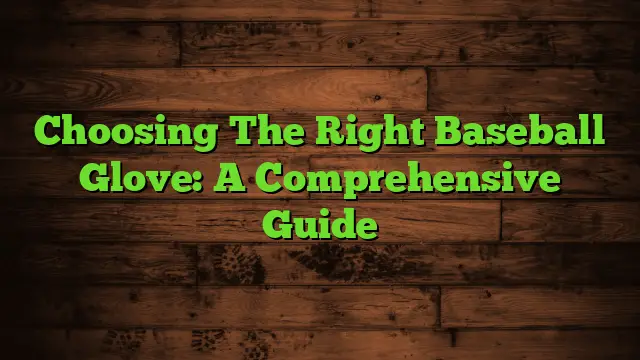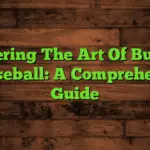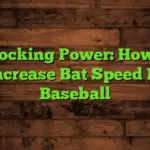Finding the perfect baseball glove can feel overwhelming, especially with so many options available. This guide will walk you through everything you need to know to choose the right baseball glove, from understanding the different types to considering your playing position and personal preferences. We’ll cover glove size, materials, patterns, and more, ensuring you make an informed decision that will enhance your performance on the field. You’ll learn how to select a glove that fits comfortably, performs reliably, and lasts for years.
A baseball glove is a specialized piece of protective equipment worn by baseball players to catch thrown and batted balls. Its design incorporates padding and a deep pocket to help absorb the impact of the ball and secure a catch. The glove’s construction impacts its durability, feel, and overall performance.
Why is Choosing
the Right Glove Important?
A properly chosen glove significantly impacts a player’s performance. An ill-fitting or poorly constructed glove can lead to discomfort, missed catches, and even injuries. Conversely, a well-chosen glove provides comfort, confidence, and a significant advantage on the field. It’s an investment that pays dividends in terms of skill development and overall enjoyment of the game.
Glove Types and Sizes
Glove Types:
- Infield Gloves: Smaller and more compact, designed for quick reactions and precise throws.
- Outfield Gloves: Larger and with a deeper pocket, ideal for catching long fly balls.
- First Base Mitts: Extremely large with a wide pocket, perfect for scooping up ground balls.
- Catcher’s Mitts: Large and heavily padded, designed to protect the catcher from fast-moving balls.
Determining the Right Glove Size:
Glove size is measured in inches from the tip of the middle finger to the end of the glove. Youth gloves typically range from 9″ to 11.5″, while adult gloves can range from 11.5″ to 13″. The ideal size depends on your position, hand size, and personal preference. A larger glove generally provides a larger pocket area, while a smaller glove provides greater flexibility and faster reaction times. Experimenting with different glove sizes during a fitting is highly recommended.
Glove Materials and Construction
Leather vs. Synthetic:
Baseball gloves are primarily made of leather or synthetic materials. Leather gloves are generally more durable, break in more naturally, and provide a better feel over time. However, they are also more expensive and require more maintenance. Synthetic gloves are more affordable and require less maintenance, but they may not last as long or offer the same feel as leather.
Understanding Glove Construction:
The construction of a baseball glove plays a vital role in its performance and durability. Key aspects include the stitching, the webbing (the material between the thumb and forefinger), and the overall pattern of the glove. Strong stitching is essential for preventing tears and ensuring the glove’s longevity. The type of webbing (H-web, I-web, etc.) affects the ball’s pocket location and the ease of catching different types of pitches or batted balls.
Breaking in Your Glove
The Importance of Glove Breaking in:
A new glove is stiff and will need to be broken in before it becomes comfortable and functional. Breaking in a glove involves softening the leather, molding the pocket, and achieving a comfortable fit. This process typically takes several weeks or even months, depending on the material and the techniques used.
Methods of Glove Breaking In:
- Oil or Glove Conditioner: Applying a leather conditioner softens the leather and speeds up the breaking-in process.
- Regular Use: Catching balls and working the glove frequently will also help it break in naturally.
- Glove Shaping Tools: Various tools are available to help mold the glove’s pocket to your preferences.
Choosing a Glove Based on Position
Infield Gloves:
Infielders need gloves that provide quick release for throws to other bases. They need smaller, lighter gloves with a firm, shallower pocket. Popular choices often feature a closed-back design for added stability and support during quick throws.
Outfield Gloves:
Outfield gloves prioritize catching long fly balls. Therefore, they need a larger pocket to catch and secure the ball safely. These gloves often feature a more open pocket and flexible design for easy catch of the balls coming from long distances.
Catcher’s Mitt:
Catcher’s mitts are heavily padded and exceptionally large to protect the catcher and secure the balls coming at high speeds. Comfort and durability are paramount due to the rigorous demands of the position.
Understanding Glove Webbing Patterns
Different Webbing Types:
The webbing design significantly influences the feel and function of a glove. Common webbing patterns include the H-web, I-web, and modified versions that provide different levels of pocket depth and ball visibility. Some designs offer enhanced ball protection, and others allow for easier ball retrieval from the pocket.
Choosing the Right Webbing:
The optimal webbing pattern depends on the player’s position and personal preferences. Experimentation is highly valuable in finding a pattern that complements your throwing and catching style.
Glove Maintenance and Care
Cleaning Your Glove:
Regular cleaning keeps your glove looking good and performing optimally. Use a soft brush or cloth to remove dirt and debris. Avoid using harsh chemicals or excessive water, as these can damage the leather.
Storing Your Glove:
Proper storage protects your glove from moisture and warping. Keep it in a cool, dry place, ideally in a glove bag or case. Avoid exposing it to extreme temperatures or direct sunlight.
Budget Considerations
Price Range and Value:
Baseball gloves range widely in price, from affordable synthetic gloves to high-end leather gloves costing hundreds of dollars. Consider your budget and the level of performance you require when making your choice. While high-end gloves often offer superior quality and durability, more affordable options can also be excellent choices for many players.
Where to Buy a Baseball Glove
Online Retailers vs. Sporting Goods Stores:
You can purchase baseball gloves online from retailers like Amazon or Dick’s Sporting Goods, or you can visit a local sporting goods store. Shopping in a store allows you to try different gloves, helping determine the best fit and feel. Online stores often offer a wider selection and potentially lower prices, but the possibility of returning items that don’t fit is increased.
Frequently Asked Questions
What factors should I consider when buying a youth baseball glove?
For youth players, prioritize comfort and fit. A glove that is too large or too small will impede development. Choose lightweight, durable materials, and ensure the glove is age-appropriate in terms of size and design. Consider features that may help them develop proper hand positioning and catching techniques.
How do I know if a glove fits properly?
A properly fitting glove should feel comfortable without being too tight or too loose. Your fingers should reach the tips of the glove without straining. When you close your hand, your fingers should comfortably rest in the pocket. The glove should also feel secure on your hand without slipping.
What’s the difference between a closed-back and open-back glove?
A closed-back glove provides more support and stability, making it ideal for infielders and those who value a secure fit. An open-back glove offers more flexibility and breathability but might be less stable for intense plays. The choice often depends on position and playing style.
How often should I clean and condition my leather glove?
Clean your leather glove after each use, especially if it gets muddy or dirty. Conditioning should be done every few weeks, or as needed, to keep the leather supple and prevent cracking. Follow the product instructions for your chosen cleaner and conditioner.
Can I break in a glove too quickly?
Yes, forcing a glove to break in too rapidly can damage it. Avoid using excessive heat or harsh chemicals, and allow for natural break-in as much as possible. A gradual process leads to better longevity.
How long does it take to break in a baseball glove?
Breaking in a glove is a process that usually takes several weeks, though it can vary depending on the material and method. Some gloves might take several months to fully break in.
Final Thoughts
Choosing the right baseball glove is a crucial decision that impacts both your performance and your enjoyment of the game. By understanding the different types of gloves, considering your position and playing style, and taking the time to break in your glove properly, you can make a choice that will serve you well for years to come. Remember to factor in your budget, and don’t hesitate to try out several gloves before making your final decision. Invest in a high-quality glove that fits comfortably and enhances your game—you’ll thank yourself for it every time you step onto the field.
Whether you’re a seasoned pro or just starting out, the perfect glove is out there waiting for you. Now go find it and start making some amazing plays!





